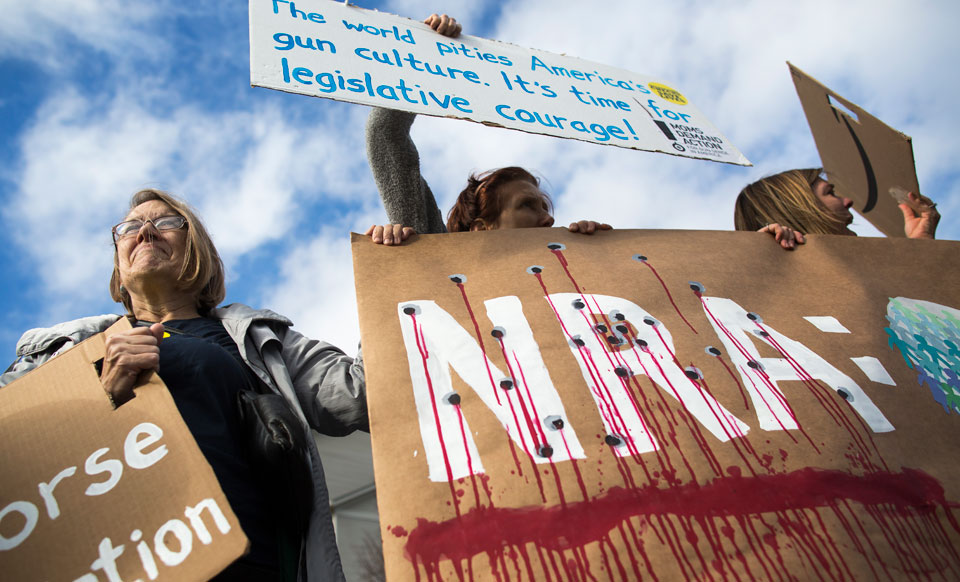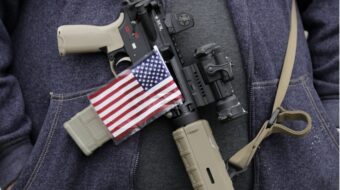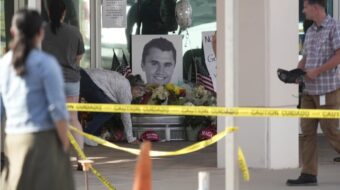
FAIRFAX, Va.—Call it holding the gun lobby accountable—or better yet, ordering politicians to get off its gravy train of campaign cash and demanding that it shut its doors.
That, and more, was the objective of thousands of marchers, led by some surviving students from the Valentine’s Day massacre at Florida’s Marjory Stoneman Douglas High School, who descended August 4 on the headquarters of the notorious National Rifle Association in a far section of Fairfax County, a D.C. suburb.
The anti-NRA march, signs, and chants on the gun lobby’s doorstep was one of two dozen such pro-gun control anti-gun lobby marches nationwide the same day. Unionists and union supporters participated in the Fairfax march, though without formal insignia or identification.
“No more dead!” ran one repeated chant. Others included “Hey, hey, NRA! How many kids did you kill today?” and “Hey, hey, ho, ho, the NRA has got to go.”
Other marches were held in New York, Chicago, Los Angeles, Dallas, San Antonio, Austin, Denver, the Twin Cities, Atlanta, Baltimore, the Bay Area, many other medium-sized cities, and several college towns. The Denver march occurred despite threats to organizers, according to the Washington Post.
An enormous pro-gun control march, complete with sharp criticism of Mayor Rahm Emanuel and his police superintendent, brought Chicago’s Lake Shore Drive to a complete halt during the evening rush hour the day before. Those marchers demanded stiff controls, accountability from politicians, and more investment in poor areas of the Windy City to provide jobs that would help curb gun violence.
All the other marches had the same goals: To keep pushing the crusade for meaningful gun control. To keep guns out of the hands of both school shooters and teachers. To vilify the gun lobby, including its role as a conduit for Russian money to GOP President Donald Trump’s 2016 political campaign.
And to put politicians on notice that unless they turn down the lobby’s cash and start listening to parents, teachers, and students and vote for real gun control in the U.S., they’ll lose.
“If any of our leaders do not share our vision of a greater society and a safer society for our kids, then vote them out,” one adult speaker declared. That chant has occurred at national pro-gun control marches for months. At the Fairfax march, it was accompanied by dozens of volunteers registering new voters.
The campaign against the gun lobby, which wraps itself in the Second Amendment’s “right to keep and bear arms,” has been mounting ever since the Florida gunman massacred three teachers, all AFT members, and 14 students at Stoneman Douglas.
Surviving Stoneman Douglas students, with nothing to lose, have led the national gun control campaign, including March for Our Lives component. One high point: An enormous pro-gun-control protest that filled Washington’s Pennsylvania Avenue from the U.S. Capitol to near the White House in spring.
The lobby responds with hysterical alarms to its members that marchers, including the students, “are trying to take our guns away.” It also demands every teacher be armed—a demand both individual teachers and their unions emphatically reject. “I don’t want to have a gun or my fellow teachers to have weapons” in schools, said special ed teacher Chris DeRosa, a National Education Association member.
“What part of ‘A well-regulated militia’ do you not understand?” one Fairfax marcher’s sign asked in reply to the NRA’s constitutional quote. The full Second Amendment reads: “A well-regulated militia being necessary to the security of a free state, the right to keep and bear arms shall not be infringed.”
But the NRA gets its power not just from its millions in campaign contributions, but from its members’ single-mindedness, judging politicians solely by their position for or against guns. At least one speaker in Fairfax said gun control advocates should start basing their vote on that sole issue, too.
Speakers and signs in Fairfax also referred, constantly, to the daily toll of gun violence in the U.S., especially in minority communities. “A bullet sees no color,” a teenaged woman student declared.
“I was taught the value of human life,” one Fairfax speaker said, over the march’s inadequate sound system. “Republicans aren’t even sending ‘thoughts and prayers’ to black and brown people murdered by guns. Our vote is our power and we will use it!”
Though many signs were pre-printed—including those picturing young gun murder victims—most were not. For many Fairfax marchers, like the Marjory Stoneman Douglas students, the protest was personal:
Annie Medding, a junior at Virginia Tech University, site of a prior massacre which killed 31 students and professors before the gunman shot himself, said it almost happened again last year. That’s even though there are safety measures all over the Blacksburg, Va., campus. “And at orientation, they made it a much bigger deal than at other campuses.”
Police were able to detect and arrest “an engineering student, just like the other guy,” who had amassed weapons and “several thousand rounds of ammunition. I remember my Mom kept texting me ‘Have you seen this?’” The “other guy” was a student, Seung Hui Cho, with untreated mental illness.
“As a girl I hope to have as many rights as a gun some day,” Medding’s two-sided sign read. The other side: “18th century laws cannot regulate 20th century weapons.” Her boyfriend, John Clark, a Radford (Va.) College senior, handmade a “2018 Back To School List” sign: “Pens & pencils…$10 Notebooks…$20 Backpack…$40 Casket…$1000 Funeral…$10,000 TOTAL…SAD!”
Edward Hale, an AFT member and Mark Twain Middle School teacher in Fairfax, started his hand-made sign several years ago. Then, it read “10,000 gun murders since Sandy Hook,” the massacre of 20 elementary school students and six teachers in Connecticut just before Christmas in 2012. Every year, he added. Recently, he’s had to change the first digit on the sign. It’s now a “5.”
“This weighs on their minds,” Hale said of his students. When some become accepting or blasé, he warns them “Don’t get used to it.” In their lively discussions, “Some want to ban all guns. Some want to do nothing. Some talk about gun laws in other countries.”
Dianne Shenton, of Annapolis, Md., came close to mourning her daughter as a mass shooting victim. Her daughter, whom she declined to name, got her first job out of college as an ad sales rep at the Annapolis Capital-Gazette. She left for another post six months ago. Her successor, Rebecca Smith, was the first of five to die on June 29 when a gunman with a grudge opened fire, then walked in, shooting.
“Even in my state, the NRA’s stranglehold has got to end,” Shenton said. “A man criminally convicted of harassment” of his spouse “was able to buy a gun a year ago” in Anne Arundel County, she noted.
Inevitably, politics got into the mix at the Fairfax march. Frequent signs denounced the pro-gun stance of Rep. Barbara Comstock, R-Va., who represents the area, and who is one of the GOP’s most-vulnerable incumbents as her district’s electorate shifts from red to purple or blue.
Comstock wasn’t the only politician marchers criticized. Some signs linked the NRA, the Republicans, and Russian donors. “Fire Congress, not guns,” one hand-made sign said. “Blood on NRA, GOP, DJT,” its other side added. DJT: Donald J. Trump. Printed around the initials: Red, bloody handprints.
Charleston, W. Va., retiree Ben Harris, said his congressman, Republican Alex Mooney, “ignores me” when he brings up gun control. His senator, Democrat Joe Manchin, who is seeking re-election this fall in the deep-red state, “is very cautious and has got one foot on each side of the line.”
“I couldn’t look my students in the eye if I didn’t come here,” explained Ronnie Ross, a middle-school teacher in nearby Fauquier County. “They heard about the march” on social media “and asked me ‘Mr. Ross, are you coming?’” he said before going off to meet their incoming school bus. “They don’t feel safe. My kids are scared.”
Ross is doing something more: Running for state senator in two years. His foe is Jill Vogel, the right-wing incumbent who was the GOP lieutenant gubernatorial nominee in the 2017 election. Her slate lost.
“I have two daughters and two grandchildren” explained Dianne Trickey-Rokenbrod, holding a “Grandmas for gun control” sign. The retired Keuka College occupational therapist traveled from her Hopewell, N.Y., home for the march. “I’m worried about the rising number of deaths by guns while our lawmakers have been bought and paid for by the NRA.”
The former registered Republican includes her congressman, Rep. Tom Reed, R-N.Y., in that indictment. But, she said, “my party left me,” and she’s changing her registration to independent. And when Reed holds town halls, says Trickey-Rokenbrod, he either “agrees to disagree” or accuses critics of “being extreme Ithaca liberals,” referring to the home city of progressive Cornell University.
“My hope is to vote them out,” she says of pro-gun lobby lawmakers “and that the NRA goes bankrupt,” referring to its money problems, reported that morning.










